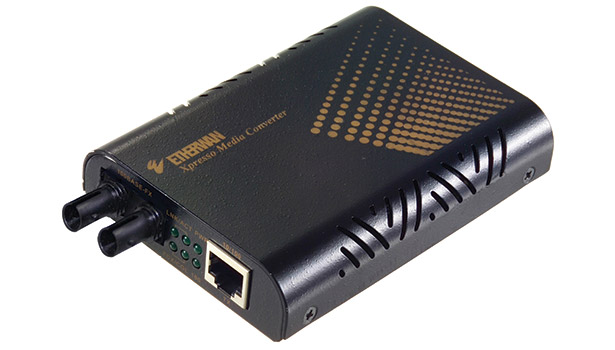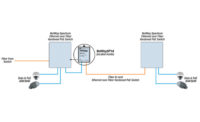One of the many benefits of using IP physical security devices is the wide variety of connectivity options available. Dealers who are knowledgeable about the various IP devices and technologies can utilize existing fiber optic cables for separate networks that can span great distances, providing connectivity to remote buildings, within large locations and on campus-type installations. These separate or “parallel” networks are the best choice for large installations because the security devices are connected to separate cables and network switches, which should eliminate any bandwidth concerns that might be raised by the client’s IT department.
The Fiber Hookup
The key concept here is that in most cases there are unused fiber optic links within cables that have been previously pulled between telecom closets. A typical scenario might be a situation in which the client has had fiber cables installed between their telecom equipment rooms. This is becoming more prevalent as 10 Gbps Ethernet is now standardized and end-users want this large-bandwidth connection to backhaul IP traffic between separate network switch arrays.
Most common fiber optic cables will contain six, 12 or 24 individual strands of fiber, each of which can be used as a separate communications path. Where the “gold” is for security dealers is that in most cases the end-user is using only two of the individual fibers to carry their IP traffic, leaving the rest of the fibers in a cable as “dark,” “unlit” or unused.
If the fibers have been properly installed, terminated and tested for industry standard performance, any of these unused fibers are ready for you to connect multiple IP physical security devices. Because of the large bandwidth capability of fiber optics, the only limiting factor to the amount or number of devices that can be connected is the switch fabric or throughput of the network switches that are connected at each end, along with the bandwidth limits of any adapters or media converters that are to be used to transmit the Ethernet signals over the existing fiber strands.
To successfully use existing fiber strands, security company personnel must have some basic knowledge of fiber, along with a method to test the fibers for proper termination and connectivity. While the science can be fairly complicated, I like to equate basic fiber optic attributes to the tires on your vehicle. As long as the tires are the right size, have decent tread and are properly inflated, your car is good to go. You don’t really need to know how the tire is built before you head out on the highway.
Most fiber optic cables are clearly stamped on the outside of the jacket every few feet with the information about the fibers inside. For example, a typical fiber cable running between two telecom closets might be labeled “6 62.5/125 OFNR.” This indicates that the fiber cable has six strands of what’s called “multimode” 62.5 micron core size fibers, and the cable is NEC rated as Optical Fiber Non-Conductive Riser, which means that this particular cable is legal to be installed within buildings and can be pulled from floor to floor. Multimode fiber comes in both 62.5 and 50 micron core diameters, can use either lasers or LEDs as transmitter lights, and is most commonly installed in large buildings or small campuses. The effective maximum distance of multimode transmission can vary based on the core size and the light source, but a quick rule of thumb is that a properly installed and terminated multimode fiber can carry 100 Mbps Ethernet out to a distance of roughly 6,400 feet. Because LED light sources are used in most cases, the devices used to transmit over multimode fiber are less expensive than their high-powered laser equivalents.
A very sure “no-go” test can be performed using a common flashlight; At one end of the fiber to be tested hold the connector tip right onto the flashlight lens (the flashlight is on). At the far end a technician can look at the connector end, and if the fiber and/or connectors are not broken, the flashlight will be visible. If the light cannot be seen and you have verified that the technicians on each end are testing the same fiber strand, that fiber isn’t usable.
If there are existing “dark” or unused fiber optic cables available, one of the easiest ways to extend LAN connectivity is using fiber to UTP media converters. These devices are extremely simple to use and connect. An example is the EtherWAN EL100T; the basic version provides a seamless transceiver capability to distances of 6,000 feet on multimode fiber. Using common ST fiber connectors, a set of these devices will transmit and receive 100 Mbps Ethernet. With these devices connected, the LAN connectivity for security devices can be quickly and inexpensively spread to any areas where the dark fibers are terminated. The EL100T also provides a form of supervision called “link fault pass through.” If the fiber connect fails these, EtherWAN transceivers will turn off the UTP Ethernet connections at each end, which will generate a failure message on PCs that are connected to the fiber link. These fiber media converters are used in sets of two, with one on each end of a fiber strand to be used.
EtherWAN also provides similar units that function with single mode fiber and different connector styles if needed. While the EL100T comes with a plug-in power supply for stand-alone use, rack mount variations are available.
The primary reasons to use existing fiber optic cables for separate IP physical security networks are the availability of abundant bandwidth, immunity to RFI and EMI interference and the simple fact that the cable is already installed. It doesn’t take a genius to see that the cost of two basic EtherWAN EL100Ts at less than $100 each is much less costly than installing hundreds of feet of new cable.
Smart dealers will be prepared to jump on existing fibers when they’re available and will win the business because of substantially lower costs in materials and labor compared with pulling new wire.










